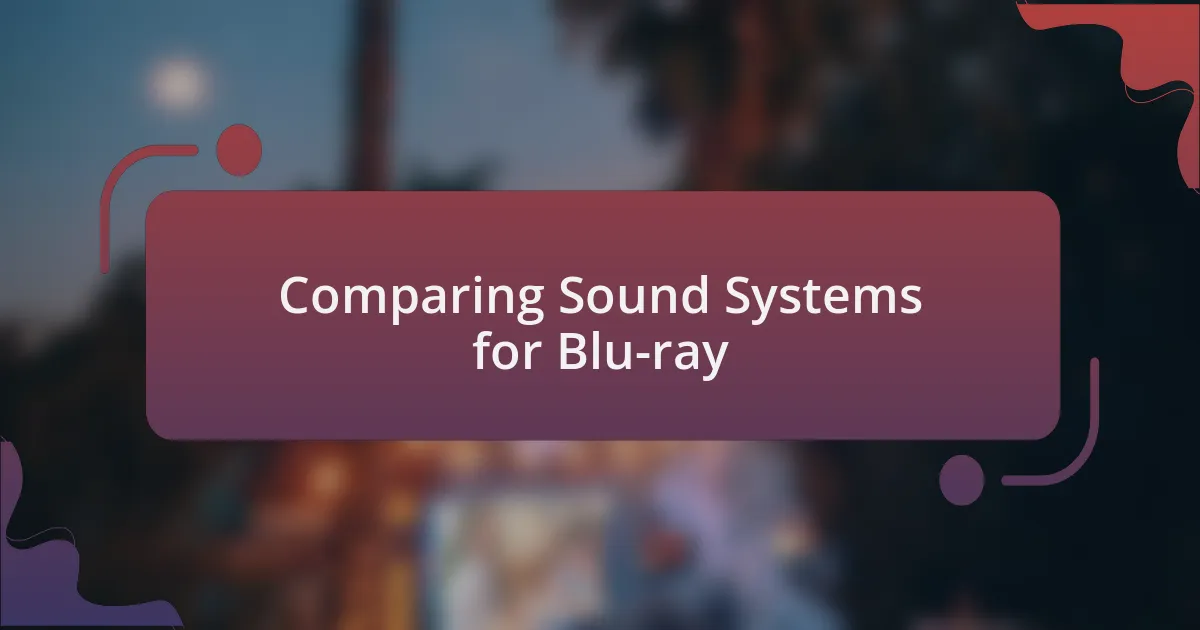Key takeaways:
- Blu-ray players offer superior picture quality, supporting 1080p and 4K resolutions, enhancing the visual experience of films.
- Sound systems significantly elevate the home entertainment experience by providing immersive audio, with clarity, balance, and depth being crucial factors.
- Compatibility with high-definition audio formats and flexible connectivity options enhance the versatility and practicality of sound systems.
- Customizing sound settings is essential for tailored audio experiences, enriching the overall enjoyment of movies and media.

Understanding Blu-ray Players
Blu-ray players have revolutionized the way we experience home entertainment. I still remember the first time I watched a movie in high definition; it was as if I had stepped into a new world. The clarity and detail brought every scene to life, making those familiar stories feel fresh and vibrant.
A key feature of Blu-ray players is their ability to support various audio formats, which I found essential for enjoying my favorite soundtracks. Have you ever listened to a piece of music that just made you feel alive? That’s the kind of experience high-resolution audio can provide. It’s not just about watching a movie; it’s about immersing yourself in every note and nuance.
Moreover, I appreciate how many Blu-ray players come with built-in streaming capabilities. It’s like having a cinema in your living room, catering to both my nostalgia for physical media and my craving for the latest releases. Isn’t it amazing how technology can bring together the best of both worlds?

Key Features of Blu-ray Players
One of the standout features of Blu-ray players is their impressive picture quality. The ability to display video in 1080p or even 4K resolution transforms movie nights into visual spectacles. I still remember the awe I felt when I watched a nature documentary that showcased vibrant colors and intricate details — it was almost like peering through a window into the world depicted on screen.
Compatibility with various formats is another key advantage. Many Blu-ray players can play not only Blu-ray discs but also DVDs and even CDs, enhancing versatility. I recall an instance when I found an old DVD tucked away in my collection; without skipping a beat, my Blu-ray player brought it to life with upgraded upscaling, making it feel like a brand-new viewing experience.
Lastly, the user-friendly interfaces of Blu-ray players often make navigation a breeze. I’ve spent countless evenings with family exploring the menus and discovering hidden features. Does it ever surprise you how intuitive these devices have become? It’s not just about playing a disc; it’s about creating a seamless entertainment experience that invites you to dive deeper into your favorite films.

Importance of Sound Systems
Sound systems play a crucial role in elevating the home entertainment experience. Imagine watching your favorite action film and feeling the vibrations of an explosion or the subtle rustle of leaves. I vividly recall a movie night where the sound system transformed dialogue into an immersive conversation, making me feel like I was part of the scene rather than just an observer.
Having a quality sound system enhances the emotional impact of films. Soundtracks, sound effects, and even silence all contribute to storytelling in powerful ways. There was a moment during a thriller that left me breathless, thanks to the chilling sound effects that perfectly complemented the suspenseful visuals. Can you remember a time when a particular sound in a movie gave you goosebumps? It’s those details that truly bring a film to life.
Additionally, a well-balanced sound system enriches the nuances of audio that many overlook. Subtle background scores can define a scene’s mood, making it essential for a truly engaging experience. I once watched a classic film with a new surround sound system, and I was amazed at how much I had missed before—the whispers of a character in a crowded room felt intimately close, drawing me deeper into the narrative.

Evaluating Sound Quality Factors
When evaluating sound quality, I focus on several key factors, including clarity, balance, and depth. I remember once discovering a sound system that truly showcased these elements during a movie screening with friends. The dialogue was crisp, and every note of the soundtrack resonated beautifully, making discussions afterward lively and animated. Isn’t that the kind of experience we all crave?
Another critical factor is the surround sound capability, which adds a layer of immersion that I find essential. I had the chance to experience a film in a well-configured 5.1 surround sound system that transported me right into the heart of the action. Each sound moved seamlessly around the room, and I often caught myself looking over my shoulder, convinced that the thunder was rolling in from behind, amplifying the excitement. Doesn’t it feel fantastic when a sound makes you turn your head in surprise?
Finally, I examine the low-frequency response, essential for conveying those powerful bass sounds that make action sequences more thrilling. I distinctly recall watching a fight scene where the deep rumble of bass was not just heard but felt in my chest. This experience reminded me how crucial that low-end impact is for thrill-inducing moments. Don’t you agree that feeling the sound can elevate our enjoyment to another level?

Comparing Sound Systems for Blu-ray
When I compare sound systems for Blu-ray, I pay close attention to their compatibility with high-definition audio formats like DTS-HD Master Audio and Dolby TrueHD. I vividly remember testing a sound system that perfectly reproduced the lush soundscapes of an epic fantasy movie. The combination of clear highs and deep lows made every scene pulse with life. Isn’t it fascinating how the specifications can significantly affect the overall experience?
Another crucial aspect I focus on is the connectivity options available. During one of my evaluations, I noticed how a system with multiple HDMI inputs made it easy to connect my Blu-ray player, gaming console, and soundbar without constant plugging and unplugging. This convenience not only streamlined my setup but also enhanced my enjoyment of different media. Have you ever been frustrated by a complicated audio setup that made you miss parts of the experience?
Ultimately, the room acoustics play a significant role in how sound systems perform. I once installed a sound system in a friend’s living room with real-time adjustments based on the unique characteristics of the space. The transformation was remarkable; the sound was no longer just coming from the speakers but enveloped the entire room. Doesn’t it make you appreciate the science behind sound when you realize how much a space can influence what you hear?

Personal Criteria for Sound Evaluation
When evaluating sound systems, I prioritize the clarity and depth of sound reproduction. I recall testing a system that claimed to enhance dialogue without losing the richness of background scores. Hearing a conversation in a film feel so natural and layered completely transformed my viewing experience. Have you ever noticed how some systems tend to muddy the dialogue with booming bass?
Another factor that I consider is the system’s ability to create an immersive experience. In one instance, I set up a surround sound system and was completely taken aback by how the sound wrapped around me, especially during a thrilling action scene. It was as if I could feel the soundwaves; I felt an adrenaline rush that took my engagement to a whole new level. Doesn’t it make you feel like you’re truly part of the story when the audio pulls you in like that?
Lastly, I assess how easy it is to customize the sound settings. I remember struggling initially with a sound system that had a convoluted interface, making it hard to tailor the sound to my preferences. Once I learned to navigate it, however, I found joy in adjusting the equalizer settings to match different genres of movies. Isn’t it empowering to fine-tune your audio experience to fit your unique tastes?